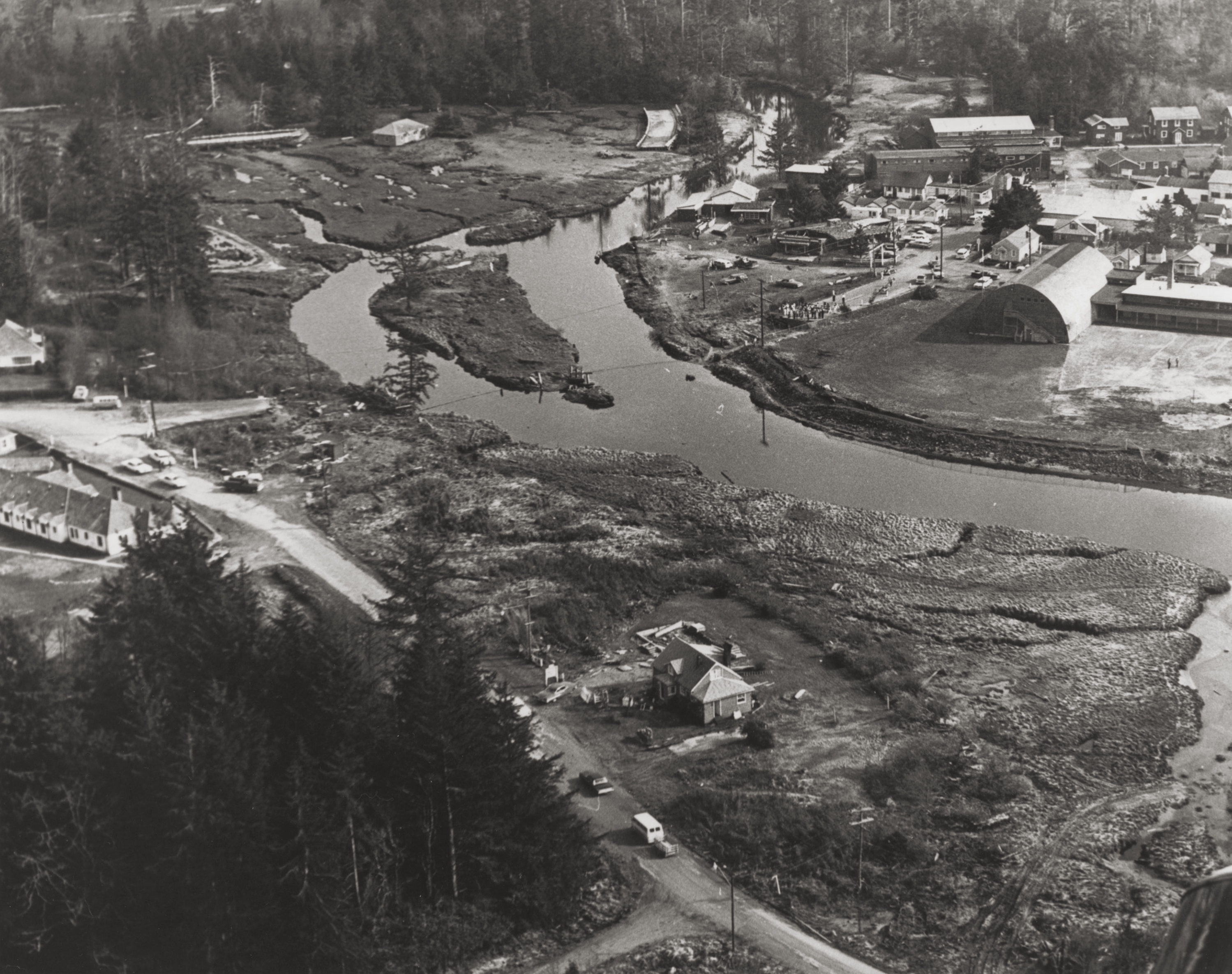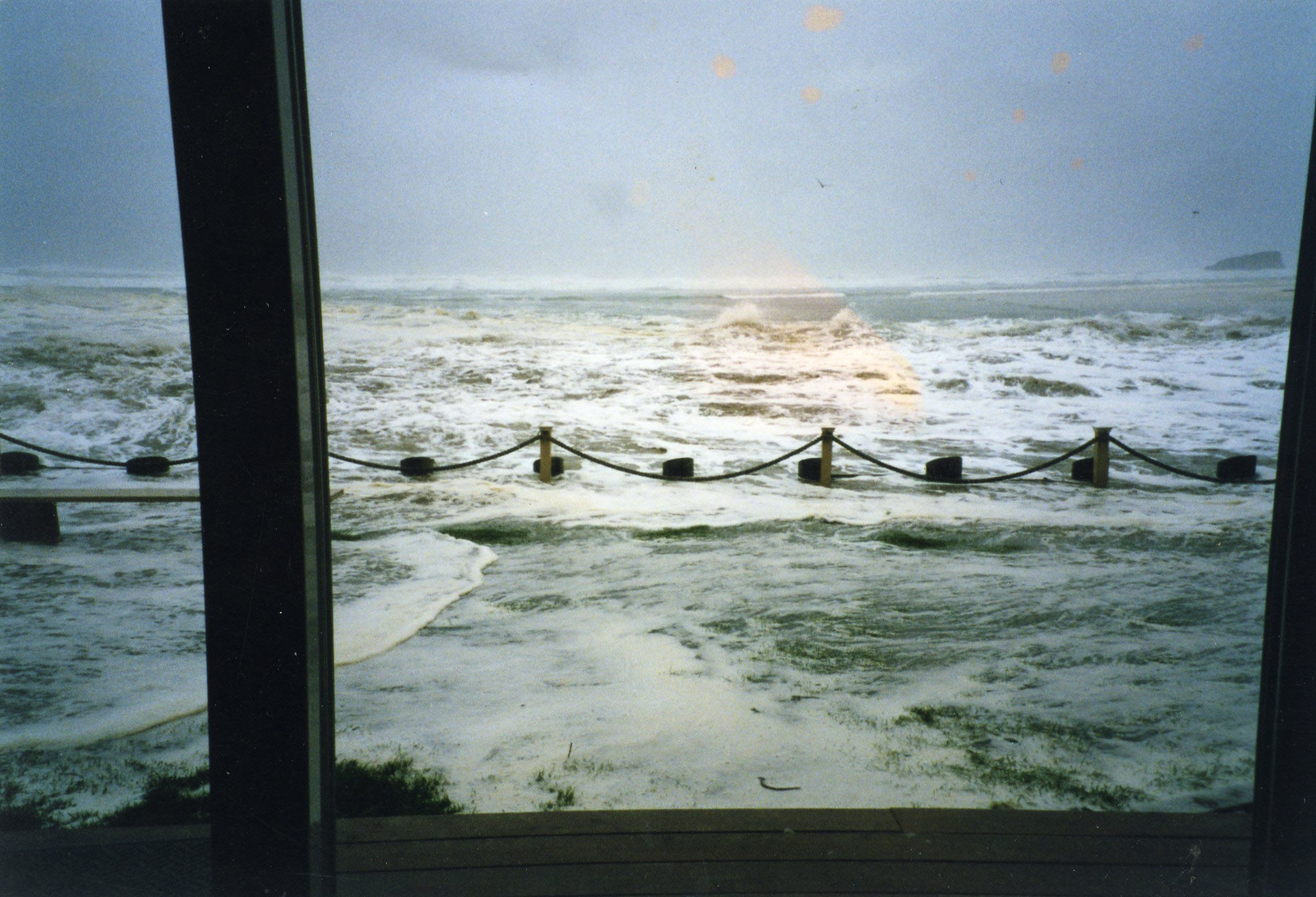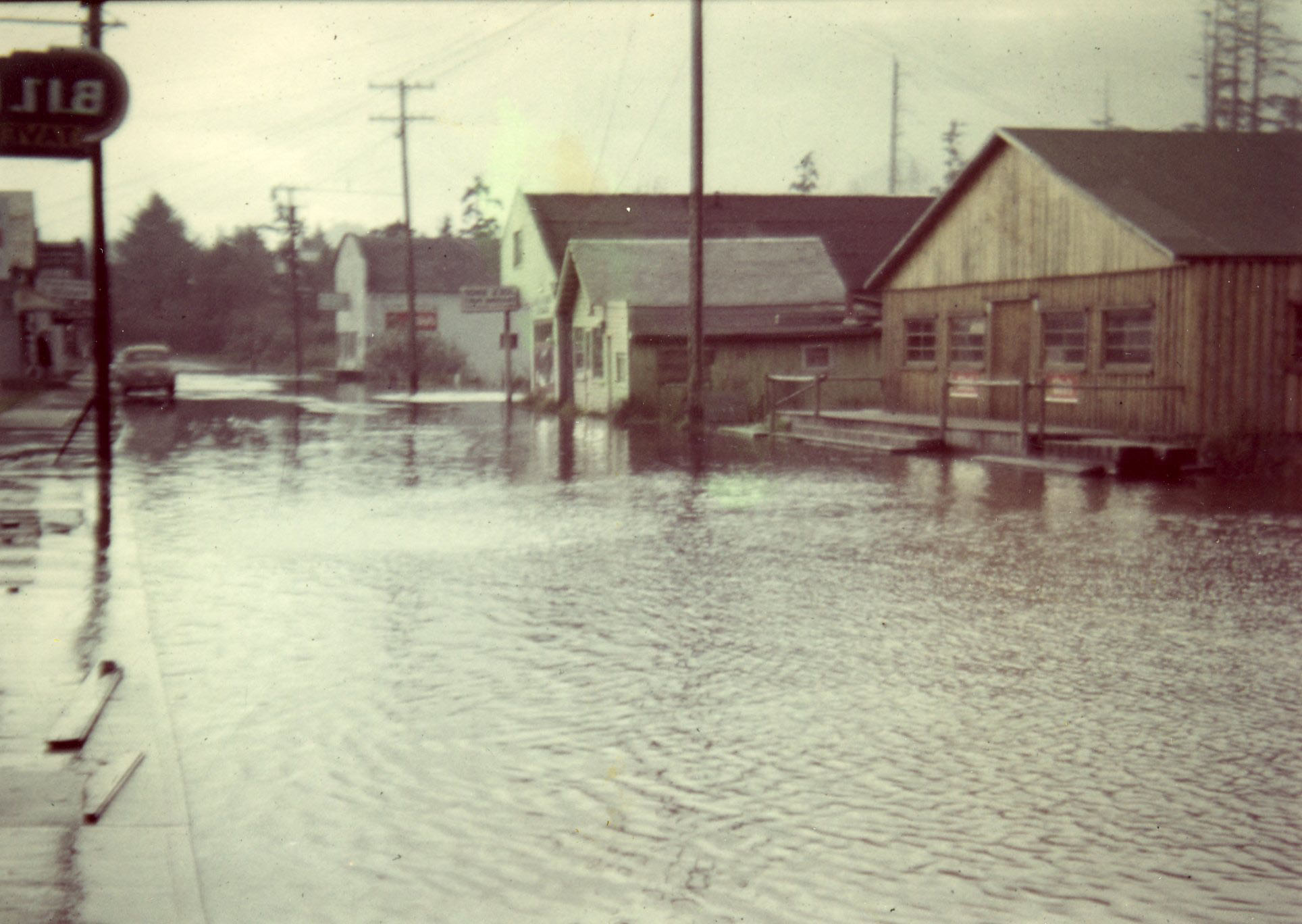
Oregon Coast Tsunami Stories
Check out our article that was recently printed in the CB Gazette on the 1964 tsunami. If you want more information or would like to see our archive of pictures of the 1964 disaster, stop by the History Center any day except Tuesday from 1 p.m. to 5 p.m.
Reflections on the Past: the Tsunami of 1964
“I was playing poker over at Frank Hammond’s house. There were six of us. The phone rang and one of the men got up and answered the phone. ‘They said there’s a tidal wave coming,’ he said. We all ignored it, because we heard that every winter, that there were some big waves coming. It wasn’t unusual to hear that. Then he got another phone call, and there was a big bet on the table. . . about fifteen dollars. . .He hung up the phone real fast, put on his coat, and headed for the door. We said, ‘Where are you going?’ He says, ‘The last wave broke over, you know that tree in my driveway. . .the last wave broke over the top of that tree.’”
That tree was 30 feet tall.
The Cannon Beach History Center recorded Bill Steidel’s story of the tsunami of 1964 in a 1995 oral history, and over 15 of the center’s 140 oral histories mention the event in some way. The tsunami was triggered by a 9.2 magnitude earthquake off the coast of Alaska, and waves as high as 27 feet hit the Pacific Northwest coastline.
Nearly 50 years later, after the recent tsunami warning and my very first evacuation, I thought it would be fitting to take a look back at what Cannon Beach residents had to say about the March 27, 1964, “tidal wave,” a reminder that the ocean in our backyard might, at any time, decide to invite itself in.
After the second phone call Steidel mentions, the men couldn’t ignore the incoming water.
“We all hit the door at the same time,” Steidel said. “And it was just like a Laurel and Hardy picture, guys trying to get out of the room, and then it was repeated, because all the guys were parked in Frank Hammond’s parking lot and they all tried to drive their cars out of the parking lot at the same time, and they couldn’t get out. It was a hell of a mess.”
Treva Haskell’s husband was one of those men. He hurried home to find his wife wondering what to do about the storm.
“In the evening, I watched the 11 o’clock news, and they said a tidal wave, that they called it then, might hit Washington and California,” Haskell said. “They didn’t mention Oregon, so I didn’t pay a whole lot of attention until I looked out the window and saw a wave breaking over the bulkhead. . . It splashed up over the edge and I thought that was awfully high tide with no storm.”
Margaret Sroufe and her husband had an up close and personal view of the tidal wave as it flushed up Ecola Creek. Her house was on the west side of Elm Street in the north end of town.
“I was the civil defense person for the north side of the creek,” Sroufe said. “If there was a problem, I was supposed to notify the residents of the area.”
She called the Seaside police when she heard about the wave on the news, but was told that until the Coast Guard recommended what needed to be done, no alerts for evacuation would be given, in case of panic. Hearing this news, Sroufe and her husband began to get ready for bed.
“I went to turn the television volume down, and I looked out the window and I saw all these green and blue flashing lights. It was when the bridge went out and broke the power lines,” she said. “And here came this water, just up, not in like a wave, just raising up. We went out on the porch and watched the water come up.”
Standing on her porch, Sroufe had a unique view of the main damage that would be done to Cannon Beach during the tsunami.
“There was a house down on the creek . . . and there was a little duplex, and the duplex started to move. . . and it hit the telephone pole, and went around the telephone pole, and it ended way back up in the pasture. And the bridge lifted up and moved on back into the pasture. It came right up to the edge of our driveway. We just stood there with our arms around each other on the porch watching the water come up,” Sroufe said. “There was a little girl who lived across the street who had been babysitting who had just walked home across the bridge. She was the last one who crossed.”
Steidel was the first to discover that the bridge was out the hard way, when trying to cross it, coming home from the poker game.
“The bridge was gone,” he said. “My family was on the other side, and I had to get over there. There was water all around me, and then a house went by. The house went over into the meadow and settled down, looked like someone had built it there. Hardly disturbed anything in the house. Somebody said all it moved was a coffee pot about a foot on the counter.”
Steidel then thought about using an old logging route to get home, but as he was on his way to the alternate route, he intercepted several cars on their way to the bridge. He stopped his vehicle and blocked their path.
“‘Get out of my way!’ one man said to me. ‘Well, I’ll get out of your way,’ I said, ‘but you’re not going that way because the bridge is gone.’ ‘Gone?’ the man said. ‘Yes! Gone!’ I told him.”
In addition to the bridge being swept away, many homes on the north side of Ecola were besieged with water.
“The north side of the creek was devastated,” Sroufe said. “There was a campground where the Les Shirley park is today. There was one trailer there. There was one woman in that little trailer, and she got out, but the trailer was washed out, and all the houses that were close to the creek were just inundated.”
When Steidel reached home after taking the alternate logging road, he found his wife and son in a house filled with logs and foam.
Aside from the bridge and the homes on the north side of Ecola, not much else had been affected. Of course, a fair amount of debris was scattered about town and water still sat in the streets.

“There were logs and all kinds of things right down Hemlock,” Haskell said.
What saved the rest of the town, Sroufe said, was the wave’s path up Ecola Creek.
“There really wasn’t much damage in the town. The water came up all around what was Les Ordway’s service station, which is that parking area today [across from Whale Park], but it didn’t go down through the rest of the town because it came right up the creek,” Sroufe said. “It wasn’t a wave that came up over the town like tidal waves do, it just followed the easiest way it could go, up the creek.”
Although there was little damage and no casualties related to the 1964 in Cannon Beach, in Newport, the McKenzie family lost three of their children to the brutal force of the wave.
“The McKenzies were camping out at Beverly Beach State Park . . . when the tidal wave struck while they were in their sleeping bags,” The Oregon Journal reported on March 30, 1964. “When the wave receded, the McKenzies found their four children – Ricky, 6, Louise, 8, Bobby,7, and Tammy 3 – had been swept to sea. Ricky’s body was found.”
So, while no damage came from Friday morning’s tsunami scare, looking to the past is all that is necessary to understand how violent the ocean can be.
To learn more about the 1964 tsunami or to browse archives or photos of the event, stop by the History Center Wednesday through Monday from 1 p.m. to 5 p.m.


